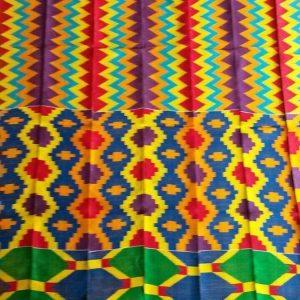Unlock the Vibrant World of Kente Cloth: A Heritage Woven in Threads
Table of Contents
Introduction
Kente cloth,a vibrant and intricate textile,has captivated the world with its mesmerizing patterns and rich cultural importance. Originating in the Ashanti Kingdom of what is now Ghana, Kente has become a symbol of African heritage and is showcased in traditional ceremonies, fashion, and art around the globe.
History and Origins
Kente cloth is believed to have its roots in the 17th century, when the Ashanti peopel developed a unique weaving technique. initially reserved for royalty and members of the elite, Kente gradually became more widely worn and gained international recognition in the 20th century.
Manufacturing Process
Kente cloth is made using a time-consuming and labor-intensive process. Artisans use handlooms to create strips of cloth in various colors and patterns, wich are then sewn together to form larger pieces. The fabric is made from cotton or silk threads, which are dyed with natural plant-based dyes.
Color and Symbolism
Each color in Kente cloth holds a specific meaning:
| Color | Symbolism |
|—|—|
| Gold | Royalty, wealth |
| Red | Death, blood, mourning |
| Green | Growth, fertility |
| Blue | Peace, serenity, trust |
| Yellow | Gold, royalty, happiness |
| Purple | Authority, wealth, knowledge |
| White | Purity, spirituality |
| Black | Maturity, authority, power |
Patterns and Motifs
Kente cloth is adorned with a vast array of patterns and motifs, each with its own significance. Some common examples include:
| Pattern | Symbolism |
|—|—|
| Adinkra symbols | Asante proverbs and symbols |
| Stripes | Royalty, status |
| Zigzags | Rivers, snakes, crocodiles |
| Circles | The moon, unity, and femininity |
| Triangles | Mountains, strength, and perseverance |
Cultural Significance
Kente cloth holds immense cultural significance for the Ashanti people and the wider African diaspora:
- Symbol of Identity: Kente is a powerful symbol of african heritage and pride, connecting people to their cultural roots.
- Traditional Ceremonies: Kente is worn during traditional ceremonies such as weddings, funerals, and political events to honor and respect ancestral traditions.
- Status and Achievement: In some cultures, different patterns and colors of Kente indicate a person’s social status, age, and achievements.
- Fashion and Art: Kente has found its way into fashion and art,inspiring designers and artists worldwide.
Benefits and Practical Tips
Kente cloth offers several benefits and practical tips to consider:
- Durability: Kente is a durable fabric that can withstand wear and tear, making it suitable for everyday use.
- Versatility: Kente can be used for a variety of purposes, from clothing to home décor and accessories.
- Care: To maintain the longevity of Kente, it’s recommended to gently hand-wash in cold water and air-dry.
- Authenticity: If purchasing Kente, it’s important to verify its authenticity from reputable sources.
Case Studies
fashion Empowerment: Ghanaian designer Ozwald boateng has showcased Kente in his collections, empowering african fashion on a global scale.
Cultural Tourism: The Kente weaving Museum in Bonwire, Ghana, attracts visitors who learn about the history and techniques of Kente weaving.
First-Hand Experience
“Wearing Kente makes me feel connected to my African heritage and gives me a sense of pride,” shares Nana Abena,a young ghanaian woman.
Conclusion
Kente cloth is a vibrant and multifaceted textile that captivates the senses and embodies the rich cultural heritage of West Africa. From its intricate patterns and symbolic colors to its durability and versatility, Kente has become an enduring symbol of African identity and creativity. By appreciating and preserving the traditions of Kente weaving, we honor the legacy of those who have woven this vibrant tapestry of threads.

